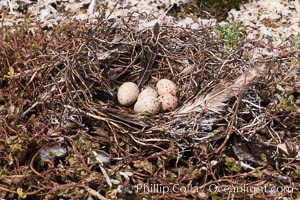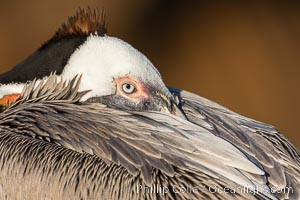
Brown pelican, resting, displaying classic winter adult breeding plumage, golden sea cliffs in the background.
Species: Brown, Pelecanus occidentalis, Pelecanus occidentalis californicus
Location: La Jolla, California
Image ID: 38969
Species: Brown, Pelecanus occidentalis, Pelecanus occidentalis californicus
Location: La Jolla, California
Image ID: 38969
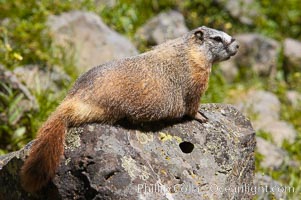
Yellow-bellied marmots can often be found on rocky slopes, perched atop boulders.
Species: Yellow-bellied marmot, Marmota flaviventris
Location: Yellowstone National Park, Wyoming
Image ID: 13055
Species: Yellow-bellied marmot, Marmota flaviventris
Location: Yellowstone National Park, Wyoming
Image ID: 13055
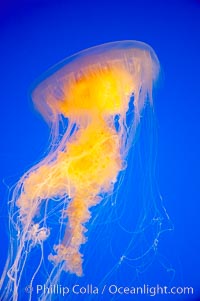
Egg-yolk jellyfish, fried egg jelly.
Species: Fried egg jellyfish, Phacellophora camtschatica
Image ID: 14035
Species: Fried egg jellyfish, Phacellophora camtschatica
Image ID: 14035
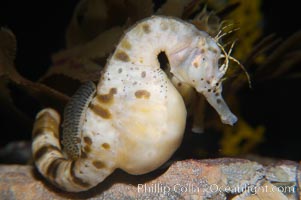
Pot-bellied seahorse, male, carrying eggs. The developing embryos are nourished by individual yolk sacs, and oxygen is supplied through a placenta-like attachment to the male. Two to six weeks after fertilization, the male gives birth. The babies must then fend for themselves, and few survive to adulthood.
Species: Pot-bellied seahorse, Hippocampus abdominalis
Image ID: 14472
Species: Pot-bellied seahorse, Hippocampus abdominalis
Image ID: 14472
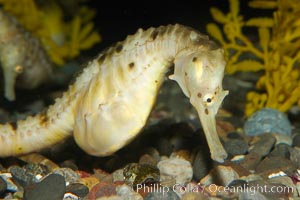
Pot-bellied seahorse, male, carrying eggs. The developing embryos are nourished by individual yolk sacs, and oxygen is supplied through a placenta-like attachment to the male. Two to six weeks after fertilization, the male gives birth. The babies must then fend for themselves, and few survive to adulthood.
Species: Pot-bellied seahorse, Hippocampus abdominalis
Image ID: 14558
Species: Pot-bellied seahorse, Hippocampus abdominalis
Image ID: 14558
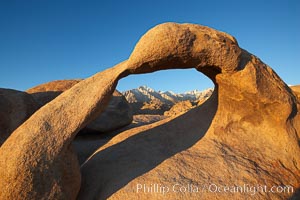
Mobius Arch in golden early morning light. The natural stone arch is found in the scenic Alabama Hlls near Lone Pine, California.
Location: Alabama Hills Recreational Area, California
Image ID: 21731
Location: Alabama Hills Recreational Area, California
Image ID: 21731
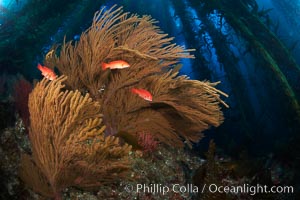
California golden gorgonian and small juvenile sheephead fishes on rocky reef, below kelp forest, underwater. The golden gorgonian is a filter-feeding temperate colonial species that lives on the rocky bottom at depths between 50 to 200 feet deep. Each individual polyp is a distinct animal, together they secrete calcium that forms the structure of the colony. Gorgonians are oriented at right angles to prevailing water currents to capture plankton drifting by.
Species: California golden gorgonian, Muricea californica, Semicossyphus pulcher
Location: San Clemente Island, California
Image ID: 23421
Species: California golden gorgonian, Muricea californica, Semicossyphus pulcher
Location: San Clemente Island, California
Image ID: 23421
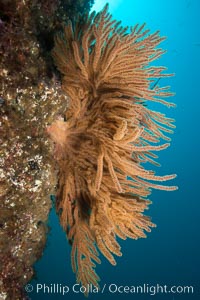
California golden gorgonian on rocky reef, underwater. The golden gorgonian is a filter-feeding temperate colonial species that lives on the rocky bottom at depths between 50 to 200 feet deep. Each individual polyp is a distinct animal, together they secrete calcium that forms the structure of the colony. Gorgonians are oriented at right angles to prevailing water currents to capture plankton drifting by.
Species: California golden gorgonian, Muricea californica
Location: San Clemente Island, California
Image ID: 25397
Species: California golden gorgonian, Muricea californica
Location: San Clemente Island, California
Image ID: 25397
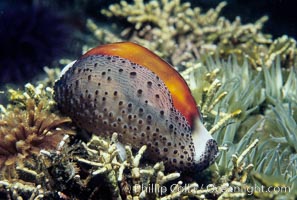
Chestnut cowrie with mantle extended, feather duster worm.
Species: Chestnut cowrie, Date cowrie, Cypraea spadicea, Eudistylia polymorpha
Location: Santa Cruz Island, California
Image ID: 01061
Species: Chestnut cowrie, Date cowrie, Cypraea spadicea, Eudistylia polymorpha
Location: Santa Cruz Island, California
Image ID: 01061
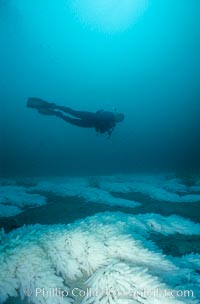
Squid eggs, La Jolla Canyon.
Species: Common squid, Loligo opalescens
Location: La Jolla, California
Image ID: 01972
Species: Common squid, Loligo opalescens
Location: La Jolla, California
Image ID: 01972
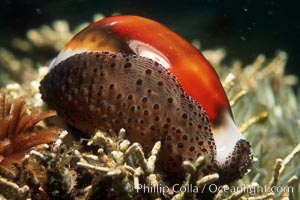
Chestnut cowry, mantle exposed.
Species: Chestnut cowrie, Date cowrie, Cypraea spadicea
Location: San Miguel Island, California
Image ID: 00624
Species: Chestnut cowrie, Date cowrie, Cypraea spadicea
Location: San Miguel Island, California
Image ID: 00624
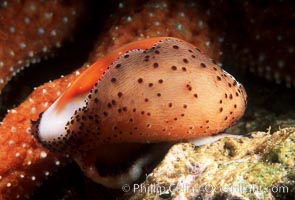
Chestnut cowrie with mantle extended.
Species: Chestnut cowrie, Date cowrie, Cypraea spadicea
Location: San Miguel Island, California
Image ID: 01062
Species: Chestnut cowrie, Date cowrie, Cypraea spadicea
Location: San Miguel Island, California
Image ID: 01062
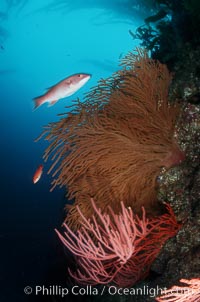
California Golden gorgonian, red gorgonian, sheephead.
Species: California golden gorgonian, Red gorgonian, Leptogorgia chilensis, Lophogorgia chilensis, Muricea californica, Semicossyphus pulcher
Location: San Clemente Island, California
Image ID: 02533
Species: California golden gorgonian, Red gorgonian, Leptogorgia chilensis, Lophogorgia chilensis, Muricea californica, Semicossyphus pulcher
Location: San Clemente Island, California
Image ID: 02533
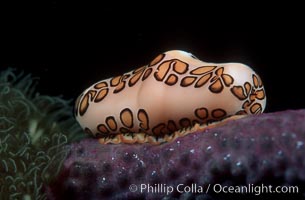
Flamingo tongue snail.
Species: Flamingo tongue cowrie, Cyphoma gibbosum
Location: Roatan, Honduras
Image ID: 02554
Species: Flamingo tongue cowrie, Cyphoma gibbosum
Location: Roatan, Honduras
Image ID: 02554
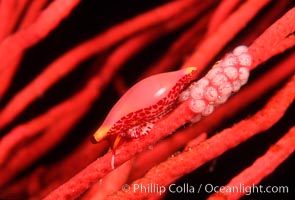
Simnia and egg cluster on gorgonian.
Species: Simnia, Delonovolva aequalis
Location: Anacapa Island, California
Image ID: 02556
Species: Simnia, Delonovolva aequalis
Location: Anacapa Island, California
Image ID: 02556
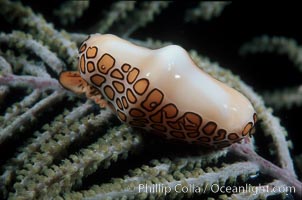
Flamingo tongue snail.
Species: Flamingo tongue cowrie, Cyphoma gibbosum
Location: Roatan, Honduras
Image ID: 02567
Species: Flamingo tongue cowrie, Cyphoma gibbosum
Location: Roatan, Honduras
Image ID: 02567
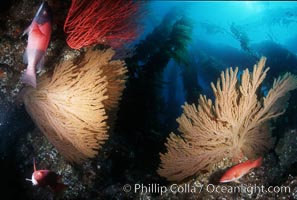
California Golden gorgonian in kelp forest.
Species: California golden gorgonian, Macrocystis pyrifera, Muricea californica
Location: San Clemente Island, California
Image ID: 03486
Species: California golden gorgonian, Macrocystis pyrifera, Muricea californica
Location: San Clemente Island, California
Image ID: 03486
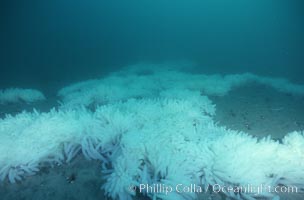
Squid egg clusters on sand.
Species: Common squid, Loligo opalescens
Location: La Jolla, California
Image ID: 05407
Species: Common squid, Loligo opalescens
Location: La Jolla, California
Image ID: 05407
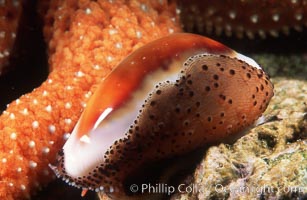
Chestnut cowrie with mantle extended.
Species: Chestnut cowrie, Date cowrie, Cypraea spadicea
Location: San Miguel Island, California
Image ID: 01035
Species: Chestnut cowrie, Date cowrie, Cypraea spadicea
Location: San Miguel Island, California
Image ID: 01035
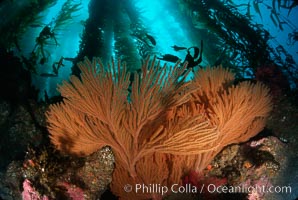
California Golden gorgonian in kelp forest.
Species: California golden gorgonian, Macrocystis pyrifera, Muricea californica
Location: San Clemente Island, California
Image ID: 01280
Species: California golden gorgonian, Macrocystis pyrifera, Muricea californica
Location: San Clemente Island, California
Image ID: 01280
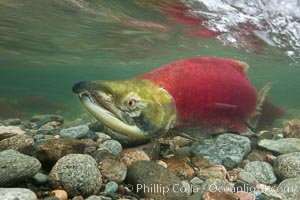
A male sockeye salmon, showing injuries sustained as it migrated hundreds of miles from the ocean up the Fraser River, swims upstream in the Adams River to reach the place where it will fertilize eggs laid by a female in the rocks. It will die soon after spawning.
Species: Sockeye salmon, Oncorhynchus nerka
Location: Adams River, Roderick Haig-Brown Provincial Park, British Columbia, Canada
Image ID: 26162
Species: Sockeye salmon, Oncorhynchus nerka
Location: Adams River, Roderick Haig-Brown Provincial Park, British Columbia, Canada
Image ID: 26162
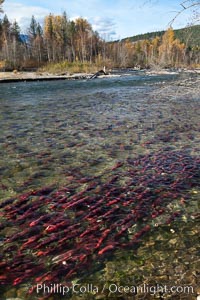
Sockeye salmon, swim upstream in the Adams River, traveling to reach the place where they hatched four years earlier in order to spawn a new generation of salmon eggs.
Species: Sockeye salmon, Oncorhynchus nerka
Location: Adams River, Roderick Haig-Brown Provincial Park, British Columbia, Canada
Image ID: 26172
Species: Sockeye salmon, Oncorhynchus nerka
Location: Adams River, Roderick Haig-Brown Provincial Park, British Columbia, Canada
Image ID: 26172
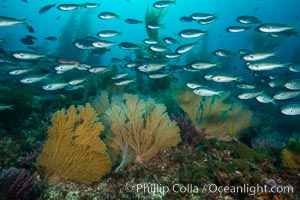
Blacksmith Chromis and California golden gorgonian on underwater rocky reef, San Clemente Island. The golden gorgonian is a filter-feeding temperate colonial species that lives on the rocky bottom at depths between 50 to 200 feet deep. Each individual polyp is a distinct animal, together they secrete calcium that forms the structure of the colony. Gorgonians are oriented at right angles to prevailing water currents to capture plankton drifting by.
Species: Blacksmith, California golden gorgonian, Chromis punctipinnis, Muricea californica
Location: San Clemente Island, California
Image ID: 30891
Species: Blacksmith, California golden gorgonian, Chromis punctipinnis, Muricea californica
Location: San Clemente Island, California
Image ID: 30891
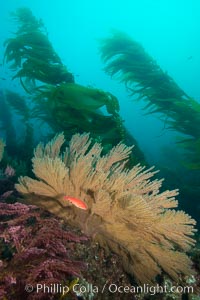
California golden gorgonian and small juvenile sheephead fishes on rocky reef, below kelp forest, underwater. The golden gorgonian is a filter-feeding temperate colonial species that lives on the rocky bottom at depths between 50 to 200 feet deep. Each individual polyp is a distinct animal, together they secrete calcium that forms the structure of the colony. Gorgonians are oriented at right angles to prevailing water currents to capture plankton drifting by.
Species: California sheephead wrasse, Semicossyphus pulcher
Location: San Clemente Island, California
Image ID: 30903
Species: California sheephead wrasse, Semicossyphus pulcher
Location: San Clemente Island, California
Image ID: 30903
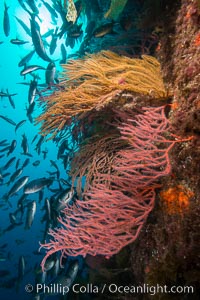
Red gorgonians and California golden gorgonians on rocky reef, below kelp forest, underwater. The red gorgonian is a filter-feeding temperate colonial species that lives on the rocky bottom at depths between 50 to 200 feet deep. Gorgonians are oriented at right angles to prevailing water currents to capture plankton drifting by.
Species: Blacksmith, California golden gorgonian, Red gorgonian, Chromis punctipinnis, Leptogorgia chilensis, Lophogorgia chilensis, Muricea californica
Location: San Clemente Island, California
Image ID: 30914
Species: Blacksmith, California golden gorgonian, Red gorgonian, Chromis punctipinnis, Leptogorgia chilensis, Lophogorgia chilensis, Muricea californica
Location: San Clemente Island, California
Image ID: 30914
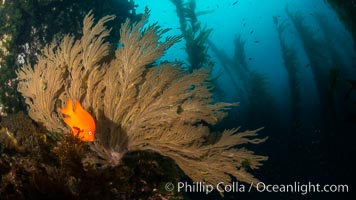
Garibaldi and California golden gorgonian on underwater rocky reef, San Clemente Island. The golden gorgonian is a filter-feeding temperate colonial species that lives on the rocky bottom at depths between 50 to 200 feet deep. Each individual polyp is a distinct animal, together they secrete calcium that forms the structure of the colony. Gorgonians are oriented at right angles to prevailing water currents to capture plankton drifting by.
Species: California golden gorgonian, Garibaldi, Hypsypops rubicundus, Muricea californica
Location: San Clemente Island, California
Image ID: 30923
Species: California golden gorgonian, Garibaldi, Hypsypops rubicundus, Muricea californica
Location: San Clemente Island, California
Image ID: 30923
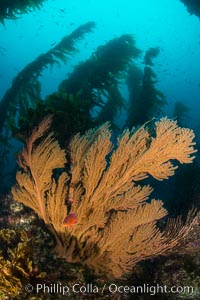
California golden gorgonian on underwater rocky reef below kelp forest, San Clemente Island. The golden gorgonian is a filter-feeding temperate colonial species that lives on the rocky bottom at depths between 50 to 200 feet deep. Each individual polyp is a distinct animal, together they secrete calcium that forms the structure of the colony. Gorgonians are oriented at right angles to prevailing water currents to capture plankton drifting by, San Clemente Island. The golden gorgonian is a filter-feeding temperate colonial species that lives on the rocky bottom at depths between 50 to 200 feet deep. Each individual polyp is a distinct animal, together they secrete calcium that forms the structure of the colony. Gorgonians are oriented at right angles to prevailing water currents to capture plankton drifting by.
Species: California golden gorgonian, Muricea californica
Location: San Clemente Island, California
Image ID: 30928
Species: California golden gorgonian, Muricea californica
Location: San Clemente Island, California
Image ID: 30928
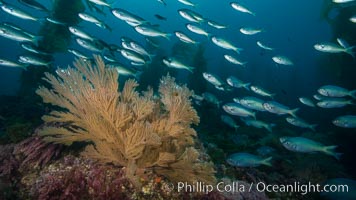
Blacksmith Chromis and California golden gorgonian on underwater rocky reef, San Clemente Island. The golden gorgonian is a filter-feeding temperate colonial species that lives on the rocky bottom at depths between 50 to 200 feet deep. Each individual polyp is a distinct animal, together they secrete calcium that forms the structure of the colony. Gorgonians are oriented at right angles to prevailing water currents to capture plankton drifting by.
Species: Blacksmith, California golden gorgonian, Chromis punctipinnis, Muricea californica
Location: San Clemente Island, California
Image ID: 30895
Species: Blacksmith, California golden gorgonian, Chromis punctipinnis, Muricea californica
Location: San Clemente Island, California
Image ID: 30895
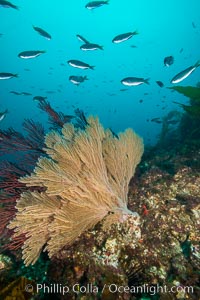
California golden gorgonian on underwater rocky reef, San Clemente Island. The golden gorgonian is a filter-feeding temperate colonial species that lives on the rocky bottom at depths between 50 to 200 feet deep. Each individual polyp is a distinct animal, together they secrete calcium that forms the structure of the colony. Gorgonians are oriented at right angles to prevailing water currents to capture plankton drifting by.
Species: California golden gorgonian, Muricea californica
Location: San Clemente Island, California
Image ID: 30900
Species: California golden gorgonian, Muricea californica
Location: San Clemente Island, California
Image ID: 30900
